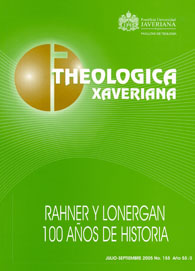Abstract
Los tiempos de crisis de comienzos del primer milenio (siglo I) suscitaron extraordinarios testimonios orales y escritos de fuerte impronta existencial que, de diversas formas, proclamaron a Jesús–Cristo como clave para afrontar, vivir y pasar a través de las dificultades y, de este modo, abrirse al futuro. Esta rica y variada gama cristológica se concentra en “fórmulas” o “títulos” cristológicos, que bien pueden considerarse como “pequeños credos” o “confesiones de fe” de carácter kerigmático. El presente artículo aborda algunos aspectos de esta riqueza, a la luz del Epílogo del Apocalipsis (22,6–21). A lo largo del artículo tenemos, como telón de fondo, una pregunta: ¿Será posible que en nuestros atormentados tiempos de comienzos del tercer milenio, también nosotros podamos encontrar en la persona, la obra, la enseñanza y la acción de Jesús–Cristo, el criterio hermenéutico de nuestra historia y de la Escritura, y la puerta que nos abre hacia el futuro y hacia la esperanza?
ALLO, E.B., Saint Jean. L’Apocalypse. Études Bibliques, 16, Gabalda, París, 1933.
BAUCKHAM, R., La teologia dell’Apocalisse. Brescia: Paideia, 1994; 40–41. Versión italiana del original en inglés: The Theology of the Book of Revelation, University Press, Cambridge, 1993.
BAUCKHAM, R., The Climax of Prophecy. Studies on the Book of Revelation, T & T Clark, Edinbrugh, 1993.
BISHOP, J., “Jesus, The First and Last”, en The Expository Times, 101, 1989, pp. 77–78.
BRÜTSCH, Ch., La Clarté de l’Apocalypse, Labor et Fides, Généve, 1966.
CLEMENS, J.S., “Alpha and Omega” , en The Expository Times, XXIII (1911–1912), 285.
COMBLIN, J., Le Christ dans L’Apocalypse, Desclée, París, 1965.
CONTRERAS M., F., El Señor de la vida. Lectura cristológica del Apocalipsis,
Sígueme, Salamanca, 1991.
CHARLIER, J.P., Comprendre l’Apocalypse. Tomo II, Cerf, Paris, 1991.
FENASSE, J.–M., “Terme et Début, voilá ce que je suis”, en Bible et Vie Chretienne 49–54, 1963, p. 50.
HOLTZ, T., Die Christologie der Apokalypse des Johannes, Akademie–Verlag, Berlín, 1962.
HOOKE, S.H., Alpha and Omega. A Study in the Pattern of Revelation, James Nisbet & Co. Ltd., London–Digswell Place, 1961.
JONGE, M. de, “The use of the Expression “o` Cristo,j” in the Apocalypse of
John” en LAMBRECHT, J. L’Apocalypse johannique et l’Apocalyptique dans
le Nouveau Testament. Bibl. Eph. Theol. Lov. LIII. Gembloux: Leuven
Univesity Press, 1980, pp. 267–281.
LÄEPPLE , A., L’Apocalypse de Jean. Livre de vie pour les chrétiens, Cerf, Paris, 1966.
MALINA, BRUCE J., On The Genre and Message of Revelation. Star Visions and Sky Journeys, Hendrickson Publishers, Inc., Massachussets, 1995.
NESTLE, Eb. “Alpha and Omega”, en The Expository Times, XXIII (1911–1912).
NUSCA, ANTHONY ROBERT, Heavenly Worship, Ecclesial Worship. A Liturgical Approach to the Hymns of the Apocalypse of St. John. Pontificiae
Universitatis Gregorianae, Roma, 1998.
PREVOST, JEAN PIERRE, Para terminar con el miedo. Paulinas, Madrid, 1987. PRIGENT, P., Les secrets de l’Apocalypse. Mystique, ésoterisme et apocalypse, Cerf, Paris, 2002.
RUSCONI, C., Vocabolario del Greco del Nuovo Testamento, EDB, Bologna, 1996.
VANNI, U., “Divenire nello Spirito”. L’Apocalisse, guida di spiritualità. Edizione ADP, Roma, 2000.
VANNI, U., “Il “Vivente” e l’ “Acqua della vita” nell’Apocalisse” en Parola, Spirito e Vita 5, 1979.
VANNI, U., La Struttura letteraria dell’Apocalisse. Morcelliana, Brescia, 1980.
This journal is registered under a Creative Commons Attribution 4.0 International Public License. Thus, this work may be reproduced, distributed, and publicly shared in digital format, as long as the names of the authors and Pontificia Universidad Javeriana are acknowledged. Others are allowed to quote, adapt, transform, auto-archive, republish, and create based on this material, for any purpose (even commercial ones), provided the authorship is duly acknowledged, a link to the original work is provided, and it is specified if changes have been made. Pontificia Universidad Javeriana does not hold the rights of published works and the authors are solely responsible for the contents of their works; they keep the moral, intellectual, privacy, and publicity rights.
Approving the intervention of the work (review, copy-editing, translation, layout) and the following outreach, are granted through an use license and not through an assignment of rights. This means the journal and Pontificia Universidad Javeriana cannot be held responsible for any ethical malpractice by the authors. As a consequence of the protection granted by the use license, the journal is not required to publish recantations or modify information already published, unless the errata stems from the editorial management process. Publishing contents in this journal does not generate royalties for contributors.


